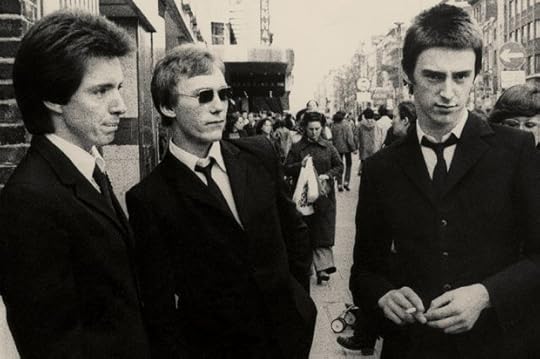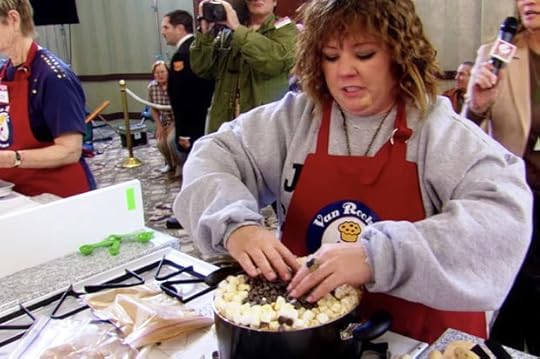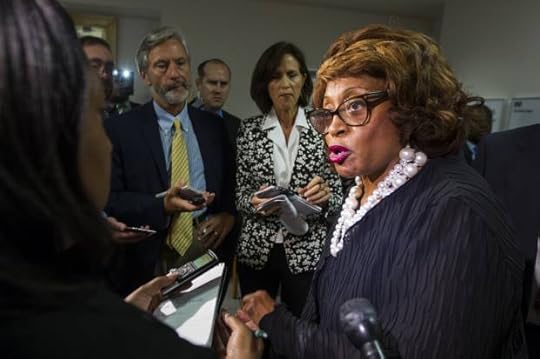Lily Salter's Blog, page 236
November 18, 2017
Fox Business host savaged for claiming “there are no allegations against” Trump

Fox Business host Maria Bartiromo made the claim on Friday that “there are no allegations” against President Donald Trump, despite him facing accusations from at least 16 women who all have said he sexually harassed them, or engaged in inappropriate conduct.
In a panel discussion Bartiromo and her guests were ripping into Sen. Al Franken, D-Minn., who was accused of groping and forcing a kiss on radio host Leeann Tweeded during a USO tour in 2006.
Bartiromo then asked one of her guests, Christopher Lu, the former assistant to President Obama, whether or not he agreed with Sen. Kirsten Gillibrand, D-N.Y., who recently said that former President Bill Clinton should have resigned when his inappropriate relationship with intern Monica Lewinsky surfaced.
Lu explained that Clinton would have likely been “seen under a different political lens” if it had come up in the current environment.
“We say that” different standards would be applied today for Clinton, Lu argued, but he also pointed out that the infamous Access Hollywood tape about President Donald Trump, and the allegations against Alabama Senate candidate Roy Moore, have surfaced.
“You need to look at this all in a whole,” Lu said. “How do you measure allegations with a photo versus allegations involving a yearbook? What are the standards when you’re looking at a political election versus legal proceedings.”
“What do you mean how do you differentiate?” Bartiromo shot back. “There’s a picture [of Franken].”
Lu pointed out that there are several allegations against Moore and “probably an equal number that have made allegations against the president.”
“So if they deny the allegations, yet you have other evidence and you have their testimony — I’m inclined to believe all of the womens’ testimonies,” Lu said.
“Just to be clear, there are no allegations against the president,” Bartiromo claimed.
After Lu clarified that the allegations were from before he was elected president, Bartiromo argued, “He said during the campaign that wasn’t true. In fact, didn’t he say also that, you know, all of this will come to light and there will be a lawsuit? I mean… we’re talking about a situation where we have a picture with the guy’s hands on her breasts. You can’t compare the two, Chris.”
Bartiromo insisted “it’s not the same at all” and it’s like comparing “apples to oranges.”
After the segment CNN’s Brian Stelter tweeted that what Bartiromo said was “really strange” considering numerous women have alleged Trump engaged in misconduct. Bartiromo then blocked Stelter on Twitter, according to screenshots he published.
I’ve always had a cordial relationship with @MariaBartiromo. I can only assume that this tweeted observation is why she suddenly blocked me… ♂️ pic.twitter.com/p6PEGTiBGk
— Brian Stelter (@brianstelter) November 18, 2017
She also blocked Huffington Post journalist Yashar, who tweeted that the Fox Business host had “just erased sixteen women.”
3. Wow @brianstelter she blocked me too after my two tweets above. pic.twitter.com/7gmtpLMcBj — Yashar Ali (@yashar) November 18, 2017
It’s not clear if her blocking spree continued, but she sure felt the wrath of the Twitter mob.
So much gaslighting, it’s a wonder @ChrisLu44 survived the carbon monoxide poisoning. (@MariaBartiromo, girl. What has happened to you.) https://t.co/QaUs9UONLb
— shauna (@goldengateblond) November 18, 2017
I remember when Maria Bartiromo was considered a serious journalist. Would love to see her bring her nonsense and state tv sensibility to 4 pm on MSNBC — Steve Schmidt (@SteveSchmidtSES) November 18, 2017
According to Sarah Sanders (and Maria Bartiromo) sexual assault allegations don’t count if you deny them. So it’s all good. https://t.co/QLk0bMctru
— Joe Remi (@JosephRemiB) November 18, 2017
Didn’t @MariaBartiromo used to be a journalist? https://t.co/7N7VskAnet — Reza Aslan (@rezaaslan) November 18, 2017
Ha! @MariaBartiromo blocked me on Twitter after I ripped her inane criticism of @NFL protests and Colin @Kaepernick7. Maria, when some media folks get on your nerves, just do what I do: ignore them. Or mute them. Blocking is just weak. https://t.co/hwPTBUTXpn
— rolandsmartin (@rolandsmartin) November 18, 2017
Crazy – uh – and what did u say about me? https://t.co/H1kgQiXKo6 — Gretchen Carlson (@GretchenCarlson) November 18, 2017
A reminder that at least 15 women have accused Donald Trump on the record of unwanted physical contact. Listen for the patterns in their stories. #inners pic.twitter.com/thoTR3OyXv
— All In w/Chris Hayes (@allinwithchris) November 18, 2017
Watch the full segment below:
To prevent climate-related disasters, invest differently

A man walks past a house laying in flood water in Catano town, in Juana Matos, Puerto Rico after Hurricane Maria (Credit: Getty/Hector Retamal)
A major blackout hit Puerto Rico’s most populated region last week, deepening the recovery crisis that has plagued the U.S. Commonwealth since Hurricane Maria hit almost two months ago.
As Maria — as well as recent disasters in Houston, Florida and northern California — have reminded us, nature is a very fickle, but also dependable force. As human beings we largely reap what we sow. Over the past 200 years, we have invested the world’s financial resources into production processes and energy sources that have caused disruption to the planet. Scientific consensus is that this has led to the intensification of natural disasters globally.
To try and addressed the damage we have caused, philanthropy has emerged as a counterforce to climate change. As Americans, we gave away $11 billion in 2016 to environmental and animal welfare organizations. This is fantastic, but it’s truly pocket change compared to the $40 trillion that circulates in the global economy every day — not to mention the close to $5 trillion represented by the market cap of publicly held fossil fuel companies. If we care about the future of our planet and want to break out of this David and Goliath fight — where philanthropy is trying to clean up the messes that the global economy has caused — we need to fundamentally change the economy, starting with the way that we invest.
How do we do this? Over the past decade, the practice of impact investment — investing dollars in a way that’s aligned with the social and environmental future we’d like to see — has become increasingly accessible. Major investors such as pension funds, endowments and foundations, are investing in innovations from wind energy to worker-owned cooperatives. And every day people are choosing to break up with their bank and seek out the local credit union or environmental bank that better reflects their values. They can also hold institutions accountable that are investing on their behalf — from that perspective we all have billions of dollars of economic influence to address climate change and just need to take advantage of that incredible opportunity to influence positive change.
But largely, social investing is still the trillion dollar trend most people have never heard of. We think finance is messy and complicated (and especially scary when our resources are running low) and try to ignore it. We might care deeply about the environment and worry about climate change, but not realize that our mutual fund is invested in fossil fuel companies. While many of us feel we lack economic power to make change, we forget that most financial institutions are accountable to the public in some way.
Are you a teacher? Check out where your pension fund is invested — if you’re lucky, it’s with a group like CALSTRS that has taken a proactive stance on climate change. Did you go to college? When they ask you to write that donation check, ask them how that money is going to be invested and if it’s in line with the future that you want to build. More than 100 educational institutions, like Stanford and the London School of Economics, have already divested from fossil fuels in some form; many could still be more proactive. Take control of your bank account and your financial relationships, and learn to become a conscious consumer of not just your fair-trade coffee and cage-free eggs but your financial investments as well, when choosing a 401(k), a mutual fund or just deciding where to store your cash.
Impact investment is a great trend, and it’s becoming widespread and easy enough that, for instance, in the case of retirement funds, you can often just check the social box when you get the application. But it’s still part of the traditional financial system — and that means it’s not a system-changing panacea. Most of these funds focus on screening out the worst offenders, when really we need to put more energy into funding viable alternatives such as clean energy. And we need to do so in a way that centers on social justice — making sure the clean energy transition builds wealth not just for historic actors but for women and people of color as well.
If we continue to invest in the status quo of environmental destruction, we can’t be surprised when it’s time to reap what we sow. But if we can invest in a clear energy future in a way that distributes wealth and power in the process, then we might be getting somewhere.
November 17, 2017
Trump lies 9 times a day on average lately

Donald Trump points to the sun as he arrives to view the solar eclipse. (Credit: AP/Andrew Harnik)
As of 3am Eastern Standard Time on Tuesday, Donald Trump has told 1,628 lies since taking office. We know this because the Washington Post has been diligently watching the numbers, keeping tabs on Trump’s huge fibs and falsehoods. Over the 298 days since his inauguration, Trump has told an average of 5.5 lies every single day of the week, Monday to Sunday. While he barely works weekdays and golfs every weekend, he apparently never takes a vacation from lying.
Over the last 35 days, Trump has been even more dishonest than usual, upping his daily average to 9 lies every 24 hours. Thanks to the extra effort he’s put into misleading the country on a diversity of topics in recent weeks, he’s likely to reach “peak liar” status by January 20. “That puts the president on track to reach 1,999 claims by the end of his first year in office, though he obviously would easily exceed 2,000 if he maintained the pace of the past month,” the Post notes.
Trump tends to lie about the same things over and over again. Near the top of his greatest hits are taxes. Trump falsely stated 40 times that GOP tax reform will yield the biggest tax cut in history, and 50 times erroneously suggested the U.S. is the highest taxed nation in the world. Fifty-five times Trump has boasted about achievements he played no part in, especially when it comes to saving or creating jobs. But Trump has lied about Obamacare more than any other topic, stating some 60 times “some variation of the statement that the Affordable Care Act is dying and ‘essentially dead,’” according to the Post. That is just not true. “Indeed, healthy enrollment for the coming year has surprised health-care experts,” according to the outlet.
Trump’s lies are dangerous for reasons many have acknowledged. Obviously, the spread of misinformation and disinformation and the obliteration of truth may hold deep consequences for society and our already flawed democracy. All politicians lie, but Trump lies habitually, and with alarming frequency. The only surprise about Trump’s lying at this point is what he chooses to lie about — how easily disprovable his lies are and how unconvincing he is after so much practice. Of course, that matters little to Trump’s base and the GOP overall, for whom whataboutism and “if true”-ism are perfectly good stand-ins for what we’re constantly told are traditional values and morals.
Get early Black Friday pricing on your new favorite wireless earbuds

While wireless listening might be the new standard, so many pairs are incredibly finicky to use: either they’re not truly wireless (still relying on a cord to hold themselves in place), constantly fall out from your ears in the middle of a workout, or need to work paired together in order to even function. Well, say goodbye to subpar wireless buds and hello to your new favorite pair: these TREBLAB X11 Earbuds.
The TREBLAB X11’s are small, discreet and deliver incredible, crisp audio. They’re truly wireless buds — meaning absolutely no wires whatsoever — and employ elite Bluetooth audio technology to deliver lag-free sound whether you’re taking a call or streaming your playlist. And with passive noise cancellation and a built-in mic, you’ll be able to tune in with perfect fidelity — no struggling to hear conference call details or your favorite band’s latest song over the sounds of the outside world.
Not only do these buds support multiple device connections, you can use them as a single earpiece or paired together. Plus, the secure ear fins give you truly wireless, sweat-proof flexibility for any activity, whether you’re running at the gym or just running late to the office.
Give yourself the listening experience you deserve: usually these TREBLAB X11 Earbuds for $199.99, but you can get them now for $36.99, or 81% off the usual price.
You’ll want to turn in early with these silky bamboo sheets

The fact that it’s getting darker earlier and earlier could be a bummer — unless you’re looking forward to snuggling up at night with this Ultra Soft 1800 Series Bamboo Bed Sheet Set. Made out of a mixture of high-quality bamboo yarns and high-strength microfiber, this is just the bedding upgrade you need to actually want to turn in early and set an alarm for later.

You know that luxurious feeling you get when you stay at a nice hotel and the sheets are wonderfully soft and fresh? Now you can get the same feeling right in the comfort of your own home. Made out of bamboo yarns, these sheets have been mercerized and pre-shrunk to stay soft and wrinkle-free for a long time. And unlike other sheets that lose their shape, these stay crisp, lending a little extra polish to your bedroom decor.

The set comes with one flat sheet, one fitted sheet and two pillowcases for your snoozing pleasure — and the fitted sheet will fit even extra thick mattresses with an all-around elastic design and deep pockets.
Get the wonderful night’s sleep you deserve — this Ultra Soft 1800 Series Bamboo Bed Sheet Set comes in three colors, including:
Grey
White
Ivory
Usually this set is $49.99, but you can get all of them now for $29.99, or 40% off the original price. For a limited time only, use the code: GIFTSHOP15 for an additional 15% off!
Charge your device in over 150 countries with this tiny travel adapter

One of the worst things about traveling anywhere internationally? Needing to use your device to coordinate travel or meet with a friend — and realizing you’re not only at low battery, but the adapter you’ve brought with you isn’t compatible with the country you’re in. This holiday season, be prepared with this OMNIA Travel Adapter.
This is the world’s smallest travel adapter, but it still manages to pack a ton of functionality into a compact design. It’s fully ready to charge your device in more than 150 countries, without you needing to lug a whole bunch of different cables and adapters around. Instead, just use the efficient sliding design to lock the proper plug into place.
This clever device supports charging for any iOS or Android smartphone or tablet, helping you save space for your carry-on — plus, the 5-in-1 interface supports US/UK/EU/AU and USB-A standards. And you’ll never need to worry about your devices frizzing out: USB BC1.2 Intelligent Chipset Standard protects USB charging, while the built-in LED charging light indicates charging status.
Prepare for holiday travel: usually this OMNIA Travel Adapter is $49, but you can get it now for $39.99. You can also save an additional 15% off with coupon code GIFTSHOP15.
Can’t stop jamming

The Jam (Credit: Polydor)
We’re all familiar with a film considered so bad that it’s good, but what of a rock and roll band so indicative of an era that it necessarily has to come from another one? That question strikes me as the root theme of both Universal’s rabblerousing new Jam box set, 1977, and the band’s very legacy.
First matters: there have been a lot of Jam box sets lately, and if they’re one of your favorite bands, you must be in manna land these days. Others will cite overkill and complain about who has the time to tour the dustbin dossier of a mod band from the late 1970s, while likely listening to crappy music in the stead of stuff like this. Because, frankly, the Jam were awesome, even if they always felt, given their era and what we remember of said era, off-kilter with rock’s thru-line and where a band like this one should have happened in it — like, say, 1965-1966, right after rock and roll got smart, and prior to psychedelia.
The year 1977 was year one so far as Jam-dom went, with Paul Weller and crew releasing two albums, the debut “In the City” and sophomore outing “This is the Modern World.” Both, of course, are included on this set, which is putting forth an argument — and these kinds are always fun to debate — that in 1977 the Jam had one of the best years any rock artist ever has.
Some other contenders for that list: the Beatles in ’63, Dylan in ’66, Elvis in ’54, Hendrix in ’67. To qualify, you need a lot of material, you probably need to kick ass on a great run of gigs, a couple all-timer albums are useful, and toss in some landmark radio/TV appearances, plus it wouldn’t hurt if you tweak the musical and cultural zeitgeist in some way as you’re launching your career/art into the exosphere.
Those first two Jam albums were admirably peppery. It’s as if Jimmy, the central character from the Who’s mod rock opera, “Quadrophenia,” took on life as bookending pieces of vinyl. A mod was short for modernist, with their glory cultural run happening in Britain’s early and mid-1960s. They loved scooters and long, long coats, pills and Tamla soul. They were the rivals of the more famous teddy boys, the throwback rockers to the Elvis, Jerry Lee, Gene Vincent era, who are remembered more today because the Beatles once dressed like them when they were but four dots in Fame’s eye.
The early Jam espoused this mod aesthetic, despite occurring more than a decade after the fact, and I think that has dogged them somewhat when we talk about the best bands. That’s why these reissues can be handy, as they take us back into Paul Weller’s songwriting. He was a tauter version, as a songwriter, than Noel Gallagher, almost two decades before the fact, with a lot of Ray Davies in him, far more than the Who’s Pete Townshend, who is often cited as a Weller forerunner.
Davies and the Kinks had a brief flirtation with nascent metal (“You Really Got Me,” “All Day and All of the Night,” “I Need You”) before ditching that for the world of ideas and observations, where what was glimpsed at a subway stop, which no one else would have even noticed, became the root of a romance that could feel timeless and Chaucerian. Era-less. Also, almost always tuneful.
Paul Weller was the same way, right from the start of the Jam’s career. The Jam made it sound like both punk and post-punk were happening simultaneously, with a band who were really neither, fleshing out tube station vignettes that became rippling musical tapestries. And goodness how they loved Motown, and could infuse black music into their schema in ways that had other white English quartets and trios executing double-takes.
The Kinks couldn’t do this, the Who tended to sound awkward — albeit manfully so — when they tried in their 1964-65 phase, while the Stones could be adroit and the Beatles often masterful. But if you find that you have a hard time starting your days, let me recommend a blast of “Non-stop Dancing” from “In the City.” That and a cup of coffee will send out onto the streets a veritable bouncy beast, primed to kick ass at that morning meeting you were worried about.
As with the Who, so much of the Jam’s early sound is built up from the rhythm guitar, and you can’t over-emphasize that notion of tautness. There is great tensile strength in songs like “I’ve Changed My Address” from the debut and the title track of the follow-up. Parts feel stretched like a steel wire, but with that wire covering a short distance, all of the energy centered on the traversal of points A to B.
It takes some serious balls to mix black rhythm and blues with English white boy rock like this. I despair when I wonder if anyone with the requisite chops would even try to today, for fear of getting branded a cultural appropriation goon. Then again, if you dropped the Jam in the here and now, I don’t think they’d care.
Genius, I have learned, does not sit around and wait for the most favorable epoch; genius gets on with it, in whatever time period it may be situated. There is always a roost, let us say — and when there is genius, there always comes a time to rule it, regardless of the specs of said roost.
For the Jam, this was the late 1970s, after Paul Weller had processed all of the music that had come out in that 1965-66 era, which probably had something to do with how he came to write the songs he did and others that he wouldn’t have been interested in writing.
But when you’re smack dab in a time period, controlled filtration doesn’t work so readily. You spend your time processing what is going on around you, because you are there in the valley, rather than up on the butte, surveying. But not so the Jam, who became the perfect 1960s band by existing in another decade, without ever sounding like a pastiche or throwback.
The demos on the box set show how fully formed Weller’s songwriting gift was before the band hit the studio. Demos can be messy, inchoate things, but with the best writers they can match, and sometimes exceed, their eventual full-band counterparts. Pete Townshend’s demo work, as collected on the “Scoop” sets, is a fine example. Weller is in that crowd, but it is the September 10, 1977 show from the Nashville — a London club — that the seasoned Jam buffs will lose their minds over.
Keep in mind: punk was thrashing your brains out in London at this time, and a very exciting time at that. Listen to this gig, though, which is more exciting still, more adrenalized, even, than punk, but so much more meticulously balanced. There is blazing away on stage, and there is whatever the Jam are doing here.
“All Around the World” sounds like a layout plan for this band’s entire career, pitched from a stage. “I said I want a reaction, all over this land,” Weller declares like a deep soul shouter who can’t leave the stage he’s already been up on all night. There’s nothing proselytizing about it. Nor is there anything especially 1977 about it, and it makes me hesitant to say that the perfect embodiment of a 1960s band really belonged in that decade at all. I hear this and it makes me think, well, just give them all the decades, then.
MC Rapsody: Women face double standard in hip-hop

Rapsody (Credit: Peter Cooper)
“It seems like we’re the scapegoats, we’re to blame for all of America’s problems,” Rapsody said of “America’s love/hate relationship with hip-hop,” after an exclusive performance on “Salon Stage.”
Rapsody is a force in the hip-hop world and recently dropped her new album “Laila’s Wisdom” to critical acclaim. She was the only feature artist on Kendrick Lamar’s “To Pimp a Butterfly” in 2015 and has received props and praise from many heavyweights in the industry, including Jay-Z.
Rapsody performed the song “Pay Up” from “Laila’s Wisdom” on “Salon Stage” and discussed the blame hip-hop often bears, women in hip-hop, and an artist’s responsibility to confront the political landscape.
“If we’re talking about guns, violence, sex, misogyny, it’s all pointed back to hip-hop,” Rapsody said. “When in reality, hip-hop is just a reflection of what’s going on in American society. It takes the mirror and holds it back up, it’s like ‘this is you.'”
She also reflected on the double standard in hip-hop where “guys can compete and all be considered greats,” but when it comes to women, artists are constantly compared and forced to compete against each other. Rapsody wants that to change. “It’s important for people to see that, especially black women, that we get along,” she said. “It’s important for young girls to see that.” Further, being a woman in hip-hop can be many things, and “comes in different sizes, styles, shapes, colors,” she said.
Watch the interview above for more on equality in hip-hop and watch the full “Salon Stage” performance on Facebook.
Tune into Salon’s live shows, “Salon Talks” and “Salon Stage,” daily at noon ET / 9 a.m. PT and 4 p.m. ET / 1 p.m. PT, streaming live on Salon and on Facebook.
The little comedy that could: Why it took 10 years for “Cook Off!” to hit theaters

Melissa McCarthy in "Cook Off!" (Credit: Lionsgate)
Actress, writer, and filmmaker Cathryn Michon set out to make an ensemble comedy set in the quaint yet cutthroat world of an all-American amateur cooking competition. The end result featured a crackerjack cast including Wendi McLendon-Covey, Melissa McCarthy, Ben Falcone, Annie Mumolo, Diedrich Bader and Niecy Nash. It had a slapstick pace, a disarmingly charming central story about sisterhood and a production team with a refreshing amount of female representation. Cut to ten years later.
A decade after it premiered at the US Comedy Arts Festival, Lionsgate is giving “Cook Off!” a theatrical premiere on November 17, along with a VOD/iTunes release. But while the bulk of the film was made when George W. Bush was president and most of its soon to be famous cast was relatively unknown, its cheerful silliness is timeless. Yet behind the scenes, the story of female filmmakers enduring in an often brutal industry feels far more relevant.
Salon spoke via phone recently to Michon, who co-wrote, co-directed and co-stars in the film (and more recently was a screenwriter for “A Dog’s Purpose”), about surviving in Hollywood and why she still has hope.
“Cook Off!” is so cute and fun and so full of just everybody. You watch it like, “Oh there’s Jim Rash!”
An Oscar winner, and he’s, like, got two lines, yes.
I’ve been telling people, “Don’t let the 10-year delay put you off!”
This is something that happens in independent film. One of our investors had a bankruptcy; the film got trapped in the bankruptcy. A good seven of the 10 years has been dealing with the federal bankruptcy court, lawyers and litigators. I mean it’s not filmmaking. We premiered a rough cut of the film in Aspen in 2007, and then all this crap happened. The film had to be completely remade, because media was lost and stuff was gone.
This film was supposed to come out when G.W. Bush was in the White House. It was supposed to come out the year that the iPhone was introduced.
We don’t even have iPhones in the movie!
No one is looking at their phones. No one’s posting on Snapchat. It is a different world.
It’s why I put in the title card that this was 2004 because, it really is. I wrote this memoir, and the part that we adapted for the film is about how I got trapped up in the world of cooking competition, which is this weird, crazy little subculture. And now with so many cooking channels and everything, it’s become something everybody thinks they can do.
With the contest in our film, they’re making stuff with refrigerator biscuits and canned meat and string cheese, so you think, “Well I could do that, right?” That’s the appeal of that world. It’s not like extreme rock climbing or something.
Right, all of us have a kitchen. Even when you look at the “,” where it’s so much more technical and high pressure and high stakes, people are still like, “I’m just a home cook and I like baking cakes for my kids!”
One of the things that we did when we shot the film that I think was pretty brilliant — and part of why it was so hard to put the movie back together — is that we saw it like a reality show. All of the multiple things were shooting at the same time. And one of the instructions that I had given to the extras was that everybody had to be cooking all the time.
So we just went to the dollar store and bought the worst, cheapest food and had the extras pick ingredients, and come up with something to cook. They had to really strategize in order to make something. If you give anybody a bunch of ingredients and say at the end of this thing, you have to have something, they’ll cook. They’ll make something.
I’m still trying too get my head around what one does ten years later to freshen a film up and try to make a go of it.
The bones of this story were always really solid. and I thought that what I knew about these competitions, from having been in them myself, is that they’ll kind of time capsule. It’s not the most fashion forward group of hip individuals that get involved in this world.
I shot new footage. The whole thing of the title sequence looking like a crazy tasty video, and the title cards was new stuff to make it feel more like how people think about food now. There were a few things that we reshot, but nothing that was the bones of the story. It had to do with connective tissue and made the film, to me, look fresher or more current in terms of food.
I imagine you have a very wide array of responses from the people who participated in it originally. Are there people who are just like, “Great, finally, I’m really happy,” and then were there others who were, “I need to forget this ever happened?”
I think all the actual creative people are pleased and happy, because I think they all love their work. Sometimes when you’re dealing with agents and managers, they might have clients that have gotten famous and don’t really want to promote something which is when they weren’t. But everyone is so good in the movie that I think that no one needs to be embarrassed.
I love that line that my character has that denial is just a really negative word for positive thinking. I have taken that line to heart over this process over many years. I just thought, this is a great little slice of Americana, and if the movie is about something larger, it’s about how are we willing to compromise ourselves to make some great leap forward or who we are in the world and all of that.
Working in the industry, in one very specific way, it feels like we are at some kind of a watershed moment. Not just in entertainment, but for women in general, in the workplace and in the world, where we have greater representation and we are taken more seriously.
So I look at someone like you, who is making films with women, who is making films with female crews, who’s been doing it all along. You didn’t wake up today and go, “Huh, I just had a great idea, I just read about Harry Weinstein and now I think women should be more involved in the industry.” Do you feel like things maybe are changing?
I tend to be irrationally optimistic; that’s the only way you get moving across a finish line like this. I wrote a piece that was in the Huffington Post about this. It’s basically an open letter to Bob Weinstein suggesting that he do penance, and that the only way to save his soul and company would be going forward with the Weinstein company [and] do nothing but hire women directors.
In show business, part of the problem is that in filmmaking the director is absolutely the boss. When you have only 4 percent of studio feature films being directed by women, you’ve created a culture that fosters this environment. It would take a radical action at that company to cleanse themselves of the 30 years of what they’d been doing. There was a great piece written by Nate Silver, about a 13-year study of something like 1,600 films to determine that when a female character is important or the most important in a film, it’s more profitable.
In my letter to Bob, I said, “By the way, if you’re going to be only hiring women directors, you’re just going to make more money. So I’m helping you; this is business.”
My management style on both films I’ve directed is, I’m collaborative. I’m not the person who storms off set, or starts barking orders; I have to cajole and plead. You don’t go into that being an asshole, because the only way somebody is going to help you put together a film, where it’s ten years now from when it was shot, is to have it be like the most fun film to work on ever.
It’s a Tom Sawyer process. It’s like, “Oh my God, wouldn’t it be fun to paint a fence?” I don’t have tons of money to tempt you. I just have [this]: isn’t this a charming, odd, quirky, fun little movie? And wouldn’t it be great if this has its moment in the sun? Wouldn’t it be great resurrect this thing?
It’s a real testament to your optimism, Cathryn.
I’m so happy when I’m on a film set. All these people come together to make something out of nothing. If that’s not the most optimistic process, I don’t know what is. I think I’m in the right business to be a cockeyed optimist. I think anybody that makes movies has to be.
This movie has had of a lot of hard lessons in making it. Nobody should take ten years to make a movie, it’s absurd. It’s not the way to do it. Just literally never quitting and never saying never, and getting other people to join in and believe in that has taught me a lot about life. I keep my eye up what I’m trying to create, and what I’m trying to accomplish, and where I want the world to be, and how I want the world to regard me as a woman. I just can’t go back from that.
This interview has been condensed and lightly edited for clarity.
Former Democratic congresswoman begs to avoid jail time for charity theft

FILE - In this Aug. 13, 2015, file photo, former Rep. Corrine Brown talks with the press in Tallahassee, Fla. Opening statements in Brown's trial have been set for April 26, 2017, for the former Florida congresswoman who pleaded not guilty to fraud charges related to a charity that prosecutors said she used as a personal slush fund. (AP Photo/Mark Wallheiser, File) (Credit: AP)
Former Democratic Rep. Corrine Brown asked for leniency from a federal judge in Florida on Friday. She faces a lengthy prison term after being convicted of stealing thousands of dollars that were meant to go to charity.
In May, a jury convicted Brown of 18 felony counts, including filing false tax returns, mail fraud, and working with others to run a fake non-profit group.
Her conviction represents a major fall from political grace. Brown was one of the first black elected officials to be elected to federal office in Florida in 1992. She represented the Jacksonville, Florida area in the U.S. House of Representatives for over 20 years as a Democrat before losing a party primary in 2016. The vote came shortly after she was indicted.
“She ran for office to be a leader of American democracy while she stole money in a multitude of ways,” assistant U.S. attorney Tysen Duva said during the sentencing hearing. “She was a historic figure. She was a trailblazer. She has positive things to point to, but what it can’t do is overshadow the offense.”
Despite her convictions, Brown is still maintaining her innocence. During her trial, she repeatedly lashed out at prosecutors, even once blaming their investigation of her activities as somehow being responsible for a nightclub shooting in Orlando. Brown had also claimed she was being prosecuted on account of her race.
Despite her earlier remarks, on Thursday, Brown tried to sound more conciliatory.
“I ask that you take into consideration all that I’ve done in my life, and I humbly ask for mercy and compassion,” Brown said, according to a local television station report.
“I never imagined I would one day be in court asking people to speak on my behalf – never,” she said. “In hindsight, I wished I had been more diligent in overseeing my personal and professional life.”
U.S. District Judge Timothy Corrigan will reveal Brown’s sentence on Dec. 4, according to records of the proceedings.




